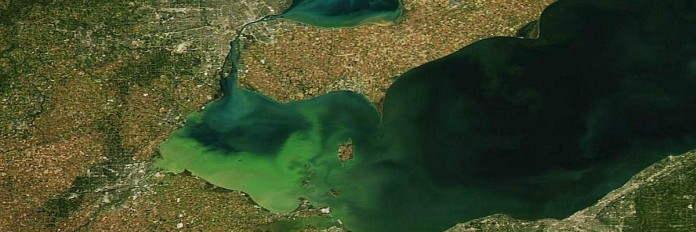SALEM, Ohio — Large-scale changes to farming are needed if states are going to meet an international goal of reducing phosphorus going into Lake Erie, a study has found.
The University of Michigan and about a dozen other scientists — some from Ohio State University and Heidelberg University — released a study March 22 that found two viable options: increase conservation practices, or convert more ground to grassland.
Last month, the U.S. and Canadian governments called for a 40 percent reduction — a figure that has been targeted in Ohio for the past several years. Excess phosphorus feeds toxin-producing algal blooms that have polluted drinking water, disrupted commerce and threatened local ecosystems.
Computer modeling
In the current study, called Informing Lake Erie Agriculture Nutrient Management via Scenario Evaluation, researchers combined computer simulation models of the Maumee Basin to study 12 possible scenarios for reducing ag-based phosphorus input.
Jay Martin, a co-author and faculty lead for OSU’s Field to Faucet water quality program, said researchers realized they had common watershed models of the basin, and wanted to see what similarities they could find, if the models were combined and different improvements were tested.
Meeting the goal
In the end, only two scenarios were shown to work. One included converting about 30,000 acres of row crops into grassland, and the other included increasing three best management practices — subsurface application of nutrients, adoption of cover crops, and buffer strips — on 50 percent of the acres in the basin.

The first scenario, while computer models suggest it would work, was quickly criticized by farmers and the ag industry, who were worried about losing productive farmland.
According to a University of Michigan news release, converting 30,000 acres in the basin, and carrying out other recommendations, would likely impact more than 6,300 farms. The average farm size, according to the university, is 235 acres.
“I agree that it could work,” Martin said, adding, “Is that the most practical and most realistic? Probably not.”
Instead, he said the more positive solution would be to increase the best management practices — things that farmers are already doing, but not currently at the level needed.
“I think farmers would be reluctant to convert their land to grassland,” Martin said, adding that the solution needs to be viable for both the environment, and for farmers.
Martin said there are government programs that make idling farm ground a viable option, including some through the Conservation Reserve Program and other USDA Natural Resources Conservation Service programs.
But, he said, if enough farmers practice the best management practices being promoted, they can maintain their current yields and acreage.
“I think the other (scenario), where we maintain the cropping acres that we have, is the most viable solution moving forward,” he said.
Major effort
Don Scavia, the University of Michigan ecologist who led the study, said the results show “it will not be possible to achieve the new target nutrient loads without very significant, large-scale implementation of these agricultural practices.”
Scavia said traditional, voluntary conservation programs would either have to be implemented at “an unprecedented scale or are simply not sufficient to reach these environmental goals, and that new complementary policies and programs are needed.”
Critical response
The study drew criticism from the Ohio Corn and Wheat Growers Association, and the Ohio Soybean Association — particularly the suggestion to convert cropland to grass.
“This is unrealistic, disregards the positive economic impact of grain farming in Ohio, and the need to grow food for a growing population,” both associations said in a released statement.
The associations also took issue with the computer-simulated models, versus real-time practices happening on the ground.
“The study did not take into account current adoption of conservation practices or the fact that some practices work best in certain geographies,” the farm associations said.
Computer shortfalls
The computer simulations give researchers the opportunity to look at potential solutions from a broad perspective, and before they’re implemented. But the study acknowledges certain shortfalls of computer modeling, including the variability from model to model.
“We chose to use multiple models because the true accuracy of the models in representing the baseline condition is not uniquely quantifiable,” the report reads, adding that with multiple models, the researchers could track the similarities.
Another challenge — and criticism of the study — is that researchers were not able to identify all of the conservation practices farmers are already doing — including buffer strips and winter cover crops.
“Care must be taken in interpreting these results because some portions of our scenarios may already be implemented to some degree within the watershed,” the report reads. “However, because of privacy issues, we were not able to determine the extent or location of many existing practices.”
With that in mind, researchers concluded that the results show the need for “additional implementation.”
The farm groups said they continue to work with on-ground researchers, from “real” farms and edge-of-field studies.
“Research, modeling, and asking the right questions can lead to solutions, but it must be based on the changing conditions that challenge farmers every single day,” the corn and soybean groups said.
About the study
Funding for the study was provided by the Fred A. and Barbara M. Erb Family Foundation. Other funding came from the National Science Foundation, a Joyce Foundation grant, a NOAA Coastal and Oceanic Climate Applications grant, and a NOAA/Ohio Sea Grant to Ohio State University.
The models used in the study, and the researchers, are from Ohio State University, Heidelberg University, LimnoTech, University of Michigan, The Nature Conservancy and Texas A&M Agrilife Research.
Related coverage:










